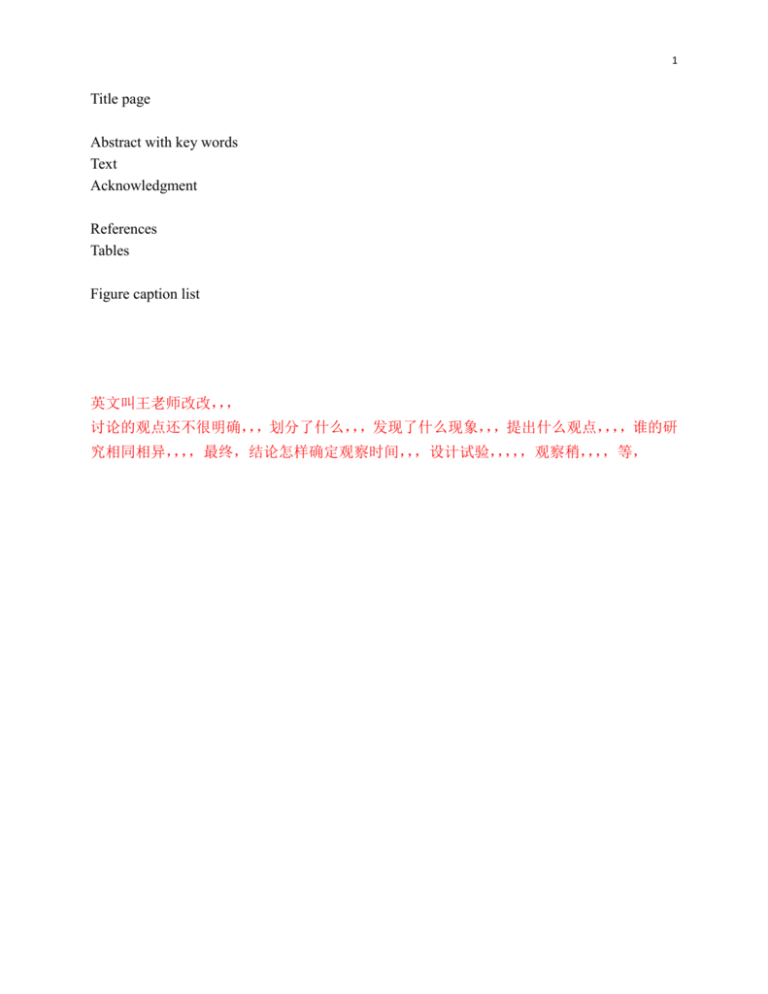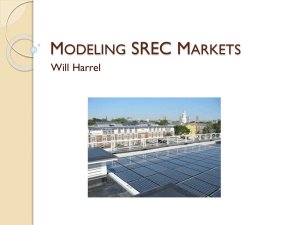Dispersal behavior of Diaphorina citri Kuwayama
advertisement

1 Title page Abstract with key words Text Acknowledgment References Tables Figure caption list 英文叫王老师改改,,, 讨论的观点还不很明确,,,划分了什么,,,发现了什么现象,,,提出什么观点,,,,谁的研 究相同相异,,,,最终,结论怎样确定观察时间,,,设计试验,,,,,观察稍,,,,等, 2 Dispersal behavior of Diaphorina citri Kuwayama (Homotera: Psyllidae) under laboratory condition Chuanqing Ruan1, Bo Liu1, Tao Li2, Hanqing Hu 1, Guocheng Fan, Yongping Duan3, David G. Hall3 1 Fujian Academy of Agricultural Sciences, Fuzhou, Fujian 350003, China;2Fujian Agriculture and Forestry University,Fuzhou,Fujian 350002, China;3 U.S. Horticultural Research Laboratory (USDA/ARS), Fort Pierce, FL 34945, USA Abstract: Asian citrus psyllid (ACP), Diaphorina citri Kuwayama, is the vector of Huanglongbing (HLB), the most devastating disease of citrus worldwide. Knowledge of ACP behavior to search host plants is helpful for understanding HLB spreading within or between citrus trees. In present research in laboratory, the behaviors of ACP adults to evaluate host plants were observed. ACP adults could disperse to seedlings of Rhododendron simsii (non host plant for ACP), Murraya panciculata L. and “Lugan”Citrus reticulata Banco when the plants were put together. The mean number of adults per plant on R. simsii was significantly lower than those on citrus and murraya at 18 h and 42 h after ACP were released, respectively. The numbers of adults on citrus and murraya became significantly different 90 h after treatment. The numbers of ACP adults per plant were not significantly different among the 3 types of murraya seedlings classified by development degrees of flushing shoots. Within a tree, the ratio of ACP adults on the new flushing shoots did not significantly increased in comparison to other parts of the tree during 1-4 d after the psyllids were released. Even on 7th day after ACP release, about 30 % adults habituated on the parts of trees other than flushing shoots. The above indicated that ACP adults spent less time to differentiate between host and non-host plants in comparison to the differentiation between different host plants species or different parts of a host plant. Keywords: Diaphorina citri Kuwayama; Huanglongbing, Dispersal behavior (用过去式比较容易,,,, The Asian citrus psyllid (ACP), Diaphorina citri Kuwayama was the vectors of Huanglongbing pathogen (HLB), the most devastating disease of citrus worldwide (Aubert 1990, da Graca 1990 ). HLB systemically infected citrus trees and caused the trees to symptomatize yellowed shoots with blotchy mottled leaves, lopsided fruits with color inversion, and aborted seeds. HLB-infected citrus trees gradually lost productivity and die in 3 to 5 yr, depending on the factors such as age of the trees and grove management (Halbert and Manjunath, 2004; Bouffard, 2006). The pathogen associated with HLB was a vector-borne, phloem limited bacterium that to date maintain uncultural in vitro. Three distinct etiologic agents of HLB were implicated on Correspondence: E-mail: fzliubo@163.com 3 the base of 16S rRNA gene sequence: Candidatus Liberibacter asiaticus (Las), Candidatus L. africanus (Laf) and Candidatus L. americanus (Lam) (Gotwald, 2010) . ACP is the vector of Las which occurs in Asia, Brazil and USA, the main regions of Citrus industry. ACP also vectors Lam in Brazil as well as in Hunan, China. The African psyllid Trioza erytreae (del Guercio) (Hemiptera: Sternorrhyncha: Triozidae) is the vector of Laf (Gotwald, 2010). The adult stage of ACP is responsible for spreading Las from infected to noninfected trees. Up to 100% of ACP adults may acquire Las as they complete their immature developmental period on Las-infected host plants (Pelz-Stelinski et al., 2010). Even ACP is not infected with Fas during nymphal development, the adults may acquire the pathogen at a rate of about 40% following 5 wk of feeding on infected plants (Pelz-Stelinski et al., 2010). ACP adults in groups transmit Las to noninfected citrus trees at a high rate (Pelz-Stelinski et al., 2010). Chao et al (1979) reported that distribution of ACP had high correlation with HLB spread. ACP adults may leap when disturbed and fly a short distance to other flush on the same or neighboring trees (Hall et al., 2011). Epidemic spread occurs more frequently within trees and rows in a grove than between rows, and long-distance spread occurs occasionally (Gottwald et al., 2010). Chiyaka et al. (2011) also pointed out that vector activity is essential for initial infection regarding the HLB distribution within a citrus tree (Chiyaka et al. 2011). ACP mates, oviposits and development on new flush shoots (Aubert 1990; Hall and Albrigo 2007). The adults preferentially feed on these flushes. The odor and color of the new flushes may play an important role in ACP activities such as detection, location and evaluation of potential host plants (Sanchez 2008; Wenninger et al. 2009; Patt & Setamou 2010). But the research by Hall & Hentz (2011) showed that the psyllid dispersal from citrus did not increase as citrus flush abundance decrease. To further understand the dispersal activity of ACP, we conducted experiments to observe the psyllids’ choice between: (1) host and non-host seedlings with bright yellow and green shoots, (2) developed leaves and flushing shoots, (3) host plants with flushing shoots at different development degrees. 了解木虱,, ,什么东西,,,研究未 见报道,,,,, 1 Materials and methods(方法中,加入试验的照片,,,,) 1.1 Maintenance of insects and host plants A laboratory colony of ACP was initiated with about 100 adults collected during June, 2010 from a M. panciculata grove in West Lake Garden in Fuzhou (26°5′49″ E, 119°17′34″N), Fujian, China. The colony was maintained on potted Murraya trees in mesh cages (125×60×50 cm) at controlled climate conditions: 27±2oC, 16L:8D photoperiod with light density of about 3000 Lux. Adult ACP were allowed to oviposit on new flushes of Murraya trees in the cages. Upon emergence, adult ACP were collected to initiate another generation or transferred onto fresh potted Murraya trees in cages (30×30×40 cm) for experiments. One-year-aged seedlings of Murraya panciculata L. were used in experiments for rearing ACP or testing the choice of ACP. Two-year-aged, 20-25 cm high seedlings of “Lugan”Citrus reticulata Banco and Rhododendron simsii were prepared for experiments. 1.2 Choice between host and non-host seedlings 4 M. panciculata and C. reticulate cv. “Lugan” were used as host plants for ACP. R. simsii was used as non-host plant for the psyllids. Six seedlings of each plant species were prepared. They were similar in height, canopy shape and all had new flushing shoots. The seedlings were randomly placed in a cage with 120 cm in length, 50 cm in width and 60 cm in height at 27±1oC,60±7% RH, and 16L : 8D photoperiod. ACP adults were released into the cage. The number of adults on each seedling was counted every day until the 6th day after releasing the psyllids. 1.3 Choice between developed leaves and flushing shoots within host plants Eighteen seedlings of M. panciculata with similar shape and new flushing shoots were placed in a cage with 120 cm in length, 50 cm in width and 60 cm in height at 27±1oC,60±7% RH, and 16L : 8D photoperiod. The number of adults on developed and developing leaves along each stem was counted every day until the 6th day after releasing the psyllids. 1.4 Choice among flushes of different development degrees within host plants Seedlings of M. panciculata were divided into 3 types: (1) seedlings with buds but no new flushing shoots, (2) seedling with new flushing shoots in length of 0.8-1.0 cm, and (3) seedlings with new flushing shoots in length of more than 1.0 cm. Six seedlings from each of the 3 types, total 18, were randomly placed in a cage with 120 cm in length, 50 cm in width and 60 cm in height at 27±1oC,60±7% RH, and 16L : 8D photoperiod. The number of adults on each plant was counted every day until the 6 th day after releasing the psyllids. 2 Results 2.1 Choice between host and non-host seedlings The released D. citri adults dispersed not only to the citrus and murraya, the host plant of the psyllids, but also to R. simsii, non-host plant of the psyllids, when the plants were placed together. In 9 h after being releases, D. citri adults on the tree tested plant species were not significantly different in terms of mean number per plant (Fig. 1). At 18 h after the release, the mean number of adults per plant on R. simsii was significantly lower than that on citrus. After 42 h of release, the adult psyllids were significantly less on R. simsii than on the two plant species, indicating that the psyllids could recognize and transfer to host plant in 42 h. 比较时,使用数据,,,不能都没数据,,,,,提出来 18 小时后,区别的规律,,,, Mean number of Diaphorina citris (adults per plant) 5 Rhododendron 40 Citrus b 35 Murraya c c b a 30 a 25 a a 20 a 15 10 a ab b b b b b a a a a a a a a 5 0 3 6 9 18 42 66 Hours after Diaphorina citri release 90 186 Fig.1. The number of Diaphorina citri adults on host plants Murraya panciculata L., “Lugan”Citrus reticulata Bancoand and non-host plant Rhododendron simsii. Mean number of Diaphorina citri (adults per plant) 2.2 Choice among flushes of different development degrees within host plants On the same day after being released, the mean numbers of D. citri adults per plant were not significantly different among the 3 types of murraya seedlings: (1) seedlings with buds but no new flushing shoots, (2) seedling with new flushing shoots in length of 0.8-1.0 cm, and (3) seedlings with new flushing shoots in length of more than 1.0 cm (Fig. 2). On the same type of murraya seedlings, the number of adult D. citri per plant was significantly increased on 2nd day after the insects were released in comparison to that on the 1st day (Fig.2). 90 80 70 60 50 40 30 20 10 0 a a aa a a 1 a aa a a a aa aa a a a a S M a L 2 3 4 5 6 7 Days after adults of Diaphorina citri release Fig. 2. Number of Diaphorina citri adults on different types of Murraya panciculata seedlings classified by development degrees of flushing shoots (S: seedlings without flushing shoots, M: seedling with new 6 flushing shoots in length of 0.8-1.0 cm, L: seedlings with new flushing shoots in length of more than 1.0 cm) 100 Flushing shoots A A 80 60 ab ab ab 60 Whole plant 50 A a a A A a A 30 b 40 20 B 10 ( 20 40 ) Total number of adults on a whole plant ( ) Percentage rate of adults on flushing shoots(%) 2.3 Choice between developed leaves and flushing shoots within host plants At 1st day after being released, D. citri adults on each plant were total a mean of 10.6, and 52.8 % of them were on the new flushing shoots (Fig. 3). On the second day, total D. citri adults per plant increased significantly, and from then on the number of adults per plant did not have significant change. The ratio of adults on flushing shoots significantly increased to 64.7% 5 d after the insects were released. This indicated that D. citri adults could dispersed to plants in a day, while they did not showed significant preference until 5 d later. 0 0 1 2 3 4 5 6 Days after Diaphorina citri adults release 7 Fig. 3. Total number of Diaphorina citri adults on each whole plant and the proportion of adults on flushing shoots 3 Disscusion Our research revealed that ACP adults were able to differentiate host plants from non-host plants in 18-42 h after they were exposed to the choice. However, the adults spent more time (about 90 h) to differentiate between their two host plant species, M. panciculata L. and C. reticulata Banco cv. “Lugan”. The volatiles emitted by plants played an important role in host plant location by ACP adults. Wenninger et al (2009) reported that ACP adults responded the odor of host plants in a Y-tube olfactometer. Patt and Sé tamou (2010) also tested positive responses of ACP adults to volatiles emitted by the flushing shoots of Murraya paniculata (L.) Jack and Citrus limon L. Burm. f. cultivar Eureka. The profiles of volatiles emitted by the foliage may possibly relate to chemotypes of essential oils derived from the leaves of the same plants (Patt and Sétamou, 2010). Though it remains unknown about the attractiveness of host plant essential oil to ACP adults, the repellent effect of non-host plants essential oil on the psyllid’s behaviors has been reported. Volatile oils from the plant species, Mikania micrantha, Lantana camera, Eupatorium catarium and Wedelia chinensis showed significant repellency effect on ACP adults, the volatile oil of 7 Eucalyptus citriodora showed neither attractive nor repellency effect on ACP adults (Cen et al., 2005). The volatile from another non-host plant, guava, Psidium guajava, possessed a repellent effect against the ACP adults (Zaka et al., 2009). On citrus leaves treated with essential oil from guava leaves, ACP adults spent longer time for non-probing and saliva secretion and mainly changed to feed in xylem (Zhu et al., 2010). It may be the combination of attractiveness of host plant odors and repellent effect of non-host plant odors that makes ACP adults to differentiate Rhododendron simsii from M. panciculata L. and C. reticulata Banco cv. “Lugan” sooner than to differentiate between the last two host plant species. But host finding behavior of ACP is complex and involves visual cues and other unknown mechanism (Lapis and Borden, 1993; Scutareanu et al., 2003; Horton and Landolt, 2007; Wenninger et al., 2008). Therefore, it may be better for evaluating resistance of genotypes against ACP to deploy non-host plant species as control experiments, especially when the number of adults on the evaluated plants is used as a part of criteria of anti-insect resistance. In our research, the numbers of ACP adults were similar on different types of murraya plants classified by development degrees of flushing shoots. Within a same host plant, proportion of ACP adults on flushing shoots over a whole plant could get significant increase 5 d after the psyllids were released. These results indicated that the adult psyllids did not show preference to plants with flushing shoots over those without flushing shoots, but within a tree more adults move to young leaves in a period of time after they were released. In the study by Yasuda et al (2005), ACP adults were also found on all parts of the Citrus depressa tree and on the M. exotica tree, but all of the ACP eggs and most of the nymphs and adults were on young shoots and young leaves. The discrepance in the results between the studies of Yasuda et al and us may be caused by light strength. The light strength in experiment of Yasuda et al is higher than ours. ACP adults present strong positive phototaxis. They did not respond significantly to host plant odors in Y-tubes in the absence of light (Patt and Sétamou, 2010). Under light irradiation, the adults displayed very minimal attraction to flushing shoots of host plant odors in a Y-tube oriented horizontally (Wenninger et al., 2009) and positive attraction in a Y-tube oriented vertically (). Behavior of ACP adults on inverted M. exotica plants revealed that males oriented to the tips of flushing shoots primarily by positive phototaxis, but females showed a preference for this part of the plants (Patt and Sétamou, 2010). The above indicate that response of ACP adults to odor of host plant’s flushing shoots is mediated by phototaxis, females and males show different sensibility to the effect of phototaxis. From the results of our observation, it appears that ACP adults fly to neighboring plants without recognizing the difference between young and older leaves. After the adults stop on a host plant, they can move to the young leaves by odor with mediation of phototaxis. Refference Chao H.Y., Chiang Y.H., Lee S.L., Chiu C.S. and Su W.F., 1979. A Preliminary Study on the Relation between the prevalence of the citrus yellow shoot (Huanglongbing) and the citrus psyllid, Diaphorina citri Kuwayama. Acta Phytopathologica Sinica, 9(2): 121-126. 8 Patt J.M. and Sétamou M., 2010. Responses of the Asian citrus psyllid to volatiles emited by the flushing shoots of its Rutaceous host plants. Environ. Entomol., 39(2): 618-624. Zhao CX, Liang YZ, Li XN, Fang HZ. Chemical components in essential oils from tender branches and leaves of Rhododendron. Yao Xue Xue Bao. 2005 Sep;40(9):854-60. Cen Y.J., Ye J.M., Xu C.B., Feng A.W., 2005. The taxis of Diaphorina citri to the volatile oils extracted from non-host plants. Journal of South China Agricultural University, 26(3): 41-44. Wenninger E.J., Stelinski L.L., and Hall D.G., 2009. Role of olfactory cues, visual cues, and mating status in orientation of Diaphorina citri Kuwayama (Hemiptera: Psyllidae) to four different host plants. Entomol. 38: 225-234. Zaka S.M., Zeng X.N., Holford P., Beattie G.A.C., 2010. Repellent effect of guava leaf volatiles on settlement of adults of citrus psylla, Diaphorina citri Kuwayama, on citrus Insect science, 17(1): 39-45. Zhu H.M., Zeng X.N., Zaka S.M., Cen Y.J., 2010. Influence of the essential oil of guava leaves on the feeding behavior of the Asina citrus psyllid. Journal of Environmental Entomology, 32(4): 483-487. Lapis E.B. and Borden J.H., 1993. Olfactory discrimination by Heteropsylla cubana (Homoptera : Psyllidae) between susceptible and resistant species of Leucaena (Leguminosae). J. Chen. Ecol. 19: 83-90. Scutareanu p., Bruin J., Posthumus M.A., and Drukker B., 2003. Constitutive and herbivore-induced volatiles in pear, alder and hawthorn trees. Chemoecology 13: 63-74. Horton D.R., and Landolt P.J., 2007. Attraction of male pear psylla, Cacopsylla pyricola, to female-infested pear shoots. Entomol. Exp. Appl. 123: 177-183. Wenninger E.J., Stelinski L.L., and Hall D.G., 2008. Behavioral evidence for a female-produced sex attractant in Diaphorina citri (Homoptera : Psyllidae). Fla. Entomol. 128: 450-459. Yasuda K., Kawamura F., and Oishi T., 2005. Location and preference of adults Asian citrus psyllid, Diaphorina citri (Homoptera: Psyllidae) on Chinese box orange jasmine, Murraya exotica L., and flat lemon, Citrus depresssa. Jap. J. Appl. Entomol. Zool. 49: 146-149. Aubert B., 1990. Integrated activities for the control of huanglongbing-greening and its vector Diaphorina citri Kuwayama in Asia, pp. 133-144. In Proceedings of the 4th Asia Pacific International Conference on Citriculture, 4-10 February 1990, Chiang-Mai, Thailand. da Graca J.V., 1991. Citrus greening disease. Annu. Rev. Phytopathol. 29: 109-136. Halbert S.E. and Manjunath K.L., 2004. Asian citrus psyllid (Sternorrhyncha: Psyllidae) and greening disease of citrus: a literature review and assessment of risk in Florida. Fla. Entomol., 87: 330-353. Bouffard, K., 2006. Greening found in 10 counties. Citrus Ind. 87 (1), 5-26. Gotwald T.M., 2010. Current epidemiclogical understanding of Citrus Huanglongbing. Annu Rev Phytopathol 48: 119-139. Pelz-Stelinski K.S., Brlansky R.H., Ebert T.A., and Rogers M.E., 2010. Transmission Parameters for Candidatus Liberibacter asiaticus by Asian citrus psyllid (Homoptera: Psyllidae). J. Econ. Entomol., 103(5): 1531-1541. 9 Gottwald T.R., 2010. Current epidemiological understanding of citrus Huanglongbing. Annu Rev Phytopathol 48: 119-139. Hall D.G., Hentz M.G., 1994. Seasonal flight activity by the Asian citrus psyllid in east central Florida. Entomol Experim Applic 139: 75-85. Chiyaka C., Singer B.H., Halbert S.E., Jr. J.G.M. and van Bruggen H.C., 2011. Modeling huanglongbing transmission within a citrus tree. PNAS, 109(30): 12213-12218.







